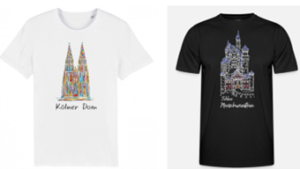Nail in the coffin for brands: Lack of distinctiveness – KÖLNER DOM
The case: It is not easy to decide whether a trade mark is devoid of any distinctive character.
We have already reported that the Free State of Bavaria has acquired the EU trade mark
![]()
as a word mark in the European Union. Just 12 days after the European Court of Justice upheld this decision, the High Cathedral of Cologne also applied to register the name of its world-famous cathedral
![]()
as a German word mark.
Both the above word marks were registered for a variety of goods and services, including clothing, and the decisions were based on the same facts. In both cases, one of the issues was whether these terms used on the apparel were distinctive and therefore eligible for protection:

The European Court of Justice had, in the Neuschwanstein case, affirmed distinctiveness, but the German Federal Supreme Court [BGH], while aware of that decision, subsequently rejected distinctiveness in relation to KÖLNER DOM.
So what were the main differences in how the distinctiveness of the two marks was assessed?
Distinctive character
To be eligible for protection, a trade mark must be capable of being perceived by the public as a distinctive sign. It must serve to identify the goods or services in question as coming from a particular undertaking and to distinguish them from the goods or services of other undertakings.
Lack of distinctiveness
However, a trade mark is not distinctive if it exclusively and immediately describes the product or its characteristics with at least one possible meaning (Absolute ground for refusal – Article 7(1)(c) of Regulation (EU) 2017/1001). Nor is it distinctive if the public understands the trade mark word only as that word, and not as a means of differentiation (Absolute ground for refusal – Article 7(1)(b) of Regulation (EU) 2017/100). The same grounds for refusal apply to national trade marks in the EU. The two grounds for refusal overlap to some extent. A mark that is capable of describing the product or its characteristics is automatically devoid of any distinctive character.
Same standards applied
Both courts applied the same standards. They even based their different decisions on the same circumstances. Both courts accepted that the respective names refer to the building on which they are based, and that the garments are everyday consumer goods.
Description?
However, the ECJ did not consider the trade-marked word to be a description of the garments, while the BGH did.
The ECJ pointed out that Neuschwanstein Castle is not known for T-shirts or their characteristics, and therefore its name does not designate an objective characteristic inherent in the nature of T-shirts. The fact that T-shirts are also marketed as souvenirs is irrelevant. The souvenir character of such everyday consumer goods depends on the free will of the buyer, not on the nature of the goods themselves. NEUSCHWANSTEIN could not therefore be cancelled.
On the other hand, the BGH stated that T-shirts bearing the name KÖLNER DOM are regularly marketed as souvenirs and are sold as a reminder of the famous site. Thus, a descriptive meaning is in the foreground. The public would not perceive KÖLNER DOM as a means of differentiation, and the mark is not eligible for protection.
Allegedly no contradiction
The BGH saw no contradiction between these two outcomes. The ECJ had based its assessment on only one aspect: the (refuted) descriptive meaning of NEUSCHWANSTEIN (Absolute ground for refusal of Article 7(1)(c) of Regulation (EU) 2017/1001); the BGH’s decision, however, was based only on the (affirmed) descriptive meaning: the public would only recognise the name KÖLNER DOM as representing the building, not as a means of differentiation (Absolute ground for refusal of Article 7(1)(b) of Regulation (EU) 2017/1001).
Each decision was based solely on a (different) aspect of distinctiveness, namely the need to preserve availability of descriptive terms (ECJ) and the lack of any distinctive character (BGH).
German Federal Supreme Court (BGH), decision of 12 October 2023 – I ZB 28/23
Learnings: If you apply for a European trade mark that is derived from the name of a famous historical site, you have a good chance of getting it registered as a trade mark. Accordingly, the names of numerous castles and historical sites have been registered as trade marks for ‘typical souvenirs’ (e.g. ‘Alhambra’, ‘Tower of London’, ‘Buckingham Palace’, ‘Windsor Castle’, ‘Sanssouci’). Unfortunately, this is not the case in Germany. If the goods are typical souvenirs, the lack of distinctiveness could present an obstacle. And on the basis of German case law, European trade marks could also be declared invalid on the basis of an absolute ground for refusal.
One might ask whether the economy is benefited by such conflicting decisions. After all, trade marks are an important part of companies’ financial decision-making and business planning. On the basis of the BGH’s opinion, the ECJ should have rejected the protectability of NEUSCHWANSTEIN. The fact that it has not done so should give pause for thought. A binding clarification of the legal situation should therefore be sought urgently from the ECJ.
Until then, if an items is to be sold in Germany, it is advisable to register the names of historical sites only for goods and services that are not considered souvenirs. To this end, the list of goods should contain only individual goods or services that do not qualify as souvenirs.